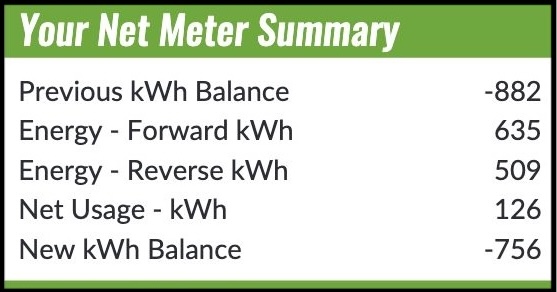Once you go solar, your electric bill will look a little different. Understanding these changes is key to seeing how your system is working and saving you money. This guide will walk you through a sample electric bill from SMECO to explain what each section means. Keep in mind that other power companies might use slightly different words, but the main ideas should be the same. Just as a reminder, your solar panels produce kilowatt-hours (kWh), which is how we measure energy use over time. Let’s break down what you’ll see on your bill.
A Classic Breakdown of an Electric Bill with Solar
When you go solar, you will have a new section on your electric bill. Below is a SMECO electric bill, so other companies may have other verbiage, but the essence should be the same. Let’s break down what these descriptions mean.

- Previous kWh Balance: This is how much Reverse – kWh (amount of kWh you pushed back to the grid) you have stored up from the previous months in the year. If this doesn’t make sense yet, read on!
- If you do not have any kWh balance, this section will not be here or read 0. This number will always be negative.
- Energy – Forward kWh: This is all the power you drew from the electric company for the current month. As you know, you are still hooked up to the electric company through your utility meter and when the solar system does not generate enough power to offset the current electric usage, you will pull any required energy from the utility.
- You pull the most power from the utility during the night, when there is no power being generated by the panels.
- Energy – Reverse kWh: This is essentially the opposite of the “Forward kWh”; this is all the power that was pushed back to the utility for the month, generated by your solar system.
- You will push the most power to the utility during a sunny day, when your current production generates more than enough power to offset the current electrical demand.
- This is not all you produced but instead all that was sent to the meter. Read more about this here.
- Net Usage – kWh: This is simply the Forward kWh, less the Reverse kWh. In the above example, the homeowner pulled 635 kWh from the grid and pushed 509 kWh back to the grid, meaning that their net kWh is 126.
- If this number is negative, you pushed more credits back to the grid than you pulled, adding to the New kWh Balance.
- New kWh Balance: This takes last month’s kWh balance (the first measure described, Previous kWh Balance), less the Net Usage – kWh.
- If this number is negative, it means you have pushed more power to the grid than you pulled for the year.
- If this number is positive, it means you have pulled more power from the grid than you pushed this year. This final number is what your kWh charges will be based on for the month.
In this example, the customer pulled more power than they pushed to the grid this month. However, since they have an existing kWh balance of -882 kWh, they will not be charged for any kWh used this month. Instead, their bill will only be the connection fee (This can range from $4.50 – $10.00, depending on your utility) and the Electric Universal Service Charge of $0.32. These flat fees allow you to be connected to the grid.
What If I Overproduce for the Year?
In April, the utility company takes the final kWh Balance and converts that to a dollar amount. This is called a “true-up” period. To find the dollar amount figure, take the final kWh Balance and multiply it by the weighted average of the Energy Charge (this may include other things, depending on your utility) over the last 12 months. As a default, that dollar amount is added to your utility account and then applied to any flat fees moving forward until it is depleted.
As of October 2023, customers (minus those in SMECO territory) may elect to accrue credits instead of receiving annual reconciliation payouts. This means that the customer’s credits will be carried over to the next year and will be used to offset the customer’s energy costs in the future.


